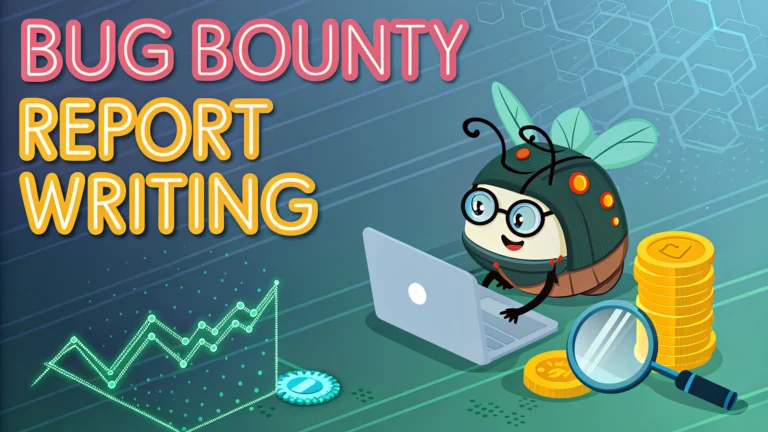Bug bounty report writing requires special attention to detail and a structured approach to effectively communicate security findings to organizations.
A well-written bug bounty report helps security teams understand, validate, and fix vulnerabilities while maximizing the chances of receiving proper recognition and rewards for discovered issues.
This guide covers the essential elements of crafting clear, professional bug bounty reports that get results and build credibility in the security research community.
Report Structure Elements
- Title: Clear, descriptive vulnerability name
- Severity Rating: CVSS score or platform-specific rating
- Affected Assets: URLs, endpoints, or components
- Technical Description: Vulnerability details
- Proof of Concept: Steps to reproduce
- Impact Assessment: Business risk explanation
- Remediation Steps: Fix recommendations
Writing the Technical Description
Start with a brief overview that a non-technical person can understand while providing enough technical depth for the security team.
Include relevant code snippets, HTTP requests/responses, and console outputs using proper formatting.
Document the exact versions of tools, browsers, and systems used during testing.
Creating an Effective Proof of Concept
- List exact steps needed to reproduce the issue
- Include screenshots or screen recordings
- Provide sample exploitation code (if allowed by program)
- Document any special environmental requirements
Impact Description Best Practices
Explain real-world consequences rather than theoretical scenarios.
Demonstrate business impact through specific examples of how the vulnerability could be exploited.
Include potential financial, reputational, or operational costs when applicable.
Common Report Writing Mistakes
- Missing reproduction steps or unclear instructions
- Overestimating severity without proper justification
- Including multiple vulnerabilities in one report
- Poor formatting or unorganized information
- Hostile or demanding language
Platform-Specific Guidelines
| Platform | Report Template | Special Requirements |
|---|---|---|
| HackerOne | Quality Report Guidelines | Structured template with weakness types |
| Bugcrowd | Writing Guide | Priority rating system |
Tools for Better Report Writing
- Screenshots: Greenshot, Lightshot
- Screen Recording: OBS Studio, Loom
- Text Formatting: StackEdit, HackMD
- HTTP Traffic: Burp Suite, OWASP ZAP
Keys to Success in Bug Bounty Reporting
Focus on quality over quantity when submitting reports.
Build relationships with program teams through professional communication.
Learn from report feedback and continuously improve your writing style.
Report Follow-up Best Practices
- Monitor report status and respond promptly to questions
- Provide additional information when requested
- Maintain professional tone in all communications
- Document any changes or updates to findings
- Verify fixes when implemented
Severity Assessment Guidelines
Use industry-standard scoring systems like CVSS to justify severity ratings.
Consider both technical impact and business context when assigning severity levels.
Key Severity Factors
- Attack complexity
- Required privileges
- User interaction needs
- Scope of impact
- Data sensitivity
Building a Strong Research Portfolio
Maintain documentation of your successful reports and lessons learned.
Track response times and resolution patterns across different programs.
- Create templates for common vulnerability types
- Document program-specific reporting preferences
- Build a library of effective proof-of-concept examples
Maximizing Bug Bounty Success
Focus on delivering clear, actionable intelligence that helps security teams protect their assets effectively.
Maintain consistent quality across all submissions to build a strong reputation in the bug bounty community.
- Stay updated with platform guidelines and program requirements
- Participate in community discussions and share knowledge
- Continuously refine your reporting methodology based on feedback
- Practice responsible disclosure and ethical research conduct
FAQs
- What is the ideal structure for a bug bounty report?
A bug bounty report should include a clear title, severity rating, vulnerability description, steps to reproduce, impact assessment, proof of concept, and suggested remediation. - How do I determine the severity level of a vulnerability?
Severity is typically assessed using the CVSS scoring system or the program’s specific criteria, considering factors like impact, exploitability, and affected assets. - What should I include in the proof of concept section?
Include screenshots, videos, or code snippets that clearly demonstrate the vulnerability. Remove any sensitive data and ensure the PoC is easily reproducible by the security team. - How detailed should the steps to reproduce be?
Steps should be detailed enough that a security team member can replicate the issue without additional guidance. Include specific URLs, parameters, and tools used. - Should I include suggested fixes in my report?
Yes, providing suggested fixes demonstrates technical knowledge and helps the security team understand potential solutions, but acknowledge that they may implement different solutions. - What common mistakes should I avoid in bug bounty reports?
Avoid submitting duplicate reports, including insufficient evidence, using unclear language, omitting impact analysis, or sharing vulnerability details publicly. - How do I handle sensitive information in reports?
Redact all sensitive data such as API keys, credentials, and personal information. Use placeholder data when necessary to demonstrate the vulnerability. - What tools should I use to document vulnerabilities?
Use screen recording software like Loom or OBS, screenshot tools with annotation capabilities, and HTTP traffic capture tools like Burp Suite or Charles Proxy. - How can I make my report stand out to program managers?
Focus on clear communication, provide thorough documentation, highlight business impact, and include chain of impact for complex vulnerabilities. - What format should I use for vulnerability titles?
Use a concise format that includes the vulnerability type and affected component, such as “Stored XSS in Profile Page” or “IDOR in User API Endpoint”.







